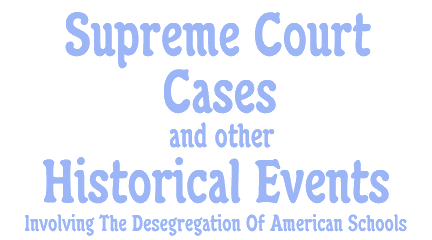

Plessy vs. Ferguson: 1896
The Supreme Court ruled that segregation in public places was constitutional as long as black and white facilities were equal.
Brown vs. Board of Education: Topeka, Kansas: 1953-1954
Linda Brown's parents were upset because she was forced to attend a school 21 blocks from her home instead of the school that was 2 blocks away because she was black and the school was for white students. The Supreme Court ruled in favor of Brown and ended segregation in schools.
Little Rock, Arkansas: 1957
The public school system was working to comply with the Federal mandate to desegregate. The school board developed and gradual and limited integration plan. The first phase was black students must enroll in an all white Central High School. Governor Faubus showed his opposition. On September 2, Faubus appeared on state wide television announcing that he had ordered the Arkansas National Guard to surround Central High to prevent 9 black students from entering the campus. On September 24, President Eisenhower put 1,000 U.S. army troopers to Little Rock to protect the black students.
Bakke Case: 1978
The Supreme Court ruled that University Admissions policies may not use quotas to achieve racial balance. Bakke, a white engineer, was refused admission to the University of California Medical School in 1973 and 1974 even though his grades and test scores were higher than several other applicants who had been excepted under a special program for members of minority groups. Bakke sued the University saying his application was rejected only because he was white.
Busing:
Busing was a program forced into states by the courts in order to achieve the desegregation of public schools. It involved transporting black and white students further away to previously "all black" and "all white" schools so that they would be integrated. Busing occurred in many places, including: Boston, Denver, and Charlotte. It aroused criticism and controversy all over. Parents and students, both black and white preferred "neighborhood schools" and opposed the extra time and travel. In 1991, in Oklahoma City Board of Education v. Dowell, the Supreme Court ruled that school districts could be released from court ordered busing as long as school officials have taken all "practicable" steps to eliminate segregation.
Sit-in at Woolworth's: 1960
Four college students who were refused service at the local Woolworth's lunch counter because they were black refused to leave and sat there, without being served, until the store closed. They returned the next day with 19 more black students. This continued for days and within a week over 400 students took turns sitting at the "white's only" lunch counter. This movement sparked countless sit ins across the south.
University of Mississippi: 1962
The state university was forced to admit its first black student,
James Meredith, an air force veteran and state native. This caused great
controversy in the south. So much that President Kennedy made a televised
appearance reminding Mississippians not to break federal law. When school
began, Meredith was escorted across campus by 320 Federal Marshals.
To The Main Segregation Page |
To The Civil Rights Project Index |